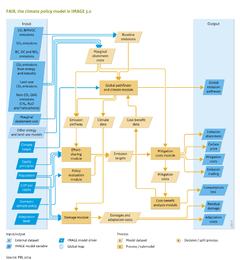Climate policy/Description: Difference between revisions
Jump to navigation
Jump to search
No edit summary |
No edit summary |
||
| Line 1: | Line 1: | ||
{{ComponentDescriptionTemplate | {{ComponentDescriptionTemplate | ||
|Reference=Den Elzen et al., 2007; Van Vuuren et al., 2011a; Meinshausen et al., 2011b; Den Elzen et al., 2013; Hof et al., 2013; Roelfsema et al., 2014; Den Elzen et al., 2012a; Hof et al., 2012; Hof et al., 2008; Hof et al., 2010; De Bruin et al., 2009; Admiraal et al., 2015; UNFCCC (2015b); Den Elzen et al., 2016; UNEP (2016); | |Reference=Den Elzen et al., 2007; Van Vuuren et al., 2011a; Meinshausen et al., 2011b; Den Elzen et al., 2013; Hof et al., 2013; Roelfsema et al., 2014; Den Elzen et al., 2012a; Hof et al., 2012; Hof et al., 2008; Hof et al., 2010; De Bruin et al., 2009; Admiraal et al., 2015; UNFCCC (2015b); Den Elzen et al., 2016; UNEP (2016); Rogelj et al., 2016; Den Elzen et al., 2015a; Kuramochi et al., 2016; Hof et al., 2016; | ||
|Description=FAIR consists of six linked modules as presented in the flowchart and described briefly below. | |Description=FAIR consists of six linked modules as presented in the flowchart and described briefly below. | ||
| Line 11: | Line 11: | ||
The Policy evaluation module calculates emission levels resulting from the | The Policy evaluation module calculates emission levels resulting from the reduction proposals and mitigation actions submitted by developed and developing countries as part of the 2015 {{abbrTemplate|UNFCCC}} Paris agreement ([[Den Elzen et al., 2016]]; [[Rogelj et al., 2016]]). Next, this module analyses the impact of planned and/or implemented domestic mitigation policies, such as carbon taxes, feed-in tariffs and renewable targets, on national emissions by 2030 to determine whether countries are on track with their reduction pledges ([[Roelfsema et al., 2014]]; [[Den Elzen et al. 2015a]]; [[Den Elzen et al., 2016]]; [[Kuramochi et al., 2016]]). The module is used in conjunction with a wide range of evaluation tools developed in cooperation with [[IIASA]] and [[JRC]], such as tools for analysing policy options for land-use credits and surplus emissions. Finally, the PBL Climate Pledge INDC tool gives a summary of the greenhouse gas emission reduction proposals, domestic policies of major countries and the impact on the emissions by 2030. | ||
Revision as of 13:49, 13 November 2016
Parts of Climate policy/Description
| Component is implemented in: |
|
| Related IMAGE components |
| Models/Databases |
| Key publications |
| References |
|
